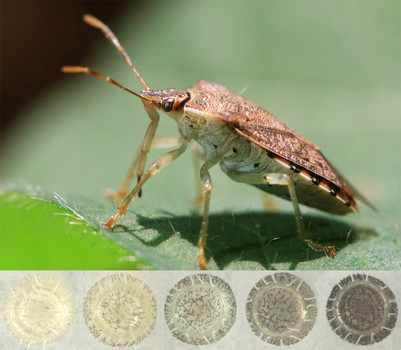Stink bugs (Podisus maculiventris) have been found to be able to control the color of their eggs depending on how much sun the eggs may be exposed to. The pigment that allows the bugs to change egg color has never been seen before. Paul Abram, a doctoral student at the University of Montreal, made the discovery almost accidentally and reported it in the edition of the journal Current Biology.
Abram noticed that female stink bugs laid darker eggs in the black squares of a crossword puzzle that lined the bottom of the bug’s cage. The bugs also laid lighter colored eggs in the white squares of the puzzle. Abram refined his observations by placing stink bugs in Petri dishes colored black and white. The bugs laid black eggs in the black dishes and white eggs in the white dishes.
The stink bugs react to the amount of light in the environment and to the color of light reflected off of surfaces in the bug’s environment. Stink bugs lay dark colored eggs on the top of leaves that receive more light. The bugs lay lighter colored eggs on the bottom of leaves where there is less light. The pigment in the eggs acts as an ultraviolet light filter. Fujita Health University School of Health Sciences in Japan performed a chemical analysis of the different colored eggs and found a new pigment that was responsible for the different colors.
This is the first animal ever found that alters the color of its eggs in response to changes in the light in the animal’s environment. The behavior protects the animal’s eggs. The researchers think that the new pigment that has yet to be named may be an example of covergent evolution that accompanied the adaptation of melanin to protect animals from light. The new pigment absorbs different wavelengths of light and transforms the light into chemical vibrations that prevent the light from harming the eggs.















